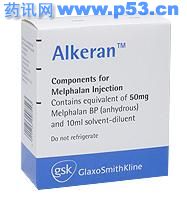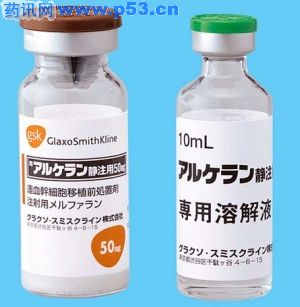| 马法兰针(爱克兰、Melphalan、Alkeran) Melphalan Alkeran 50mg/vial 适应症:Ovaries cancer, Breast cancer, Testicular cancer, Multiple myeloma, Sarcomas, melanoma 给药途径:IV infusion (以NS稀释) 稀释浓度:≦ 0.45mg/ml,以0.1mg/ml為佳 注射时间: 30 分鐘 稀释后浓度不稳定,大约每10分鐘水解10%,尽量於使用前再稀释药品 毒性及副作用: 骨髓抑制(Myelosuppression):白血球减少症(Leukopenia)及血小板减少症(thrombocytopenia) 於第21天减少到最低,老人甚至於使用药物5~6週,其值还是很低 噁心、呕吐;口角炎、腹泻在一般剂量较少发生 肺部纤维化(Fibrosis)、间质性浸润(Interstitial infiltrates)发生机率罕见 秃发:於高剂量时较常发生 过敏反应:发生率10%,过敏、发汗(diaphoresis)、低血压、心跳过快、支气管痉挛、呼吸困难、心跳停止 长期口服使用此药,约10%病人发展成第二种癌症,如急性骨髓母细胞白血病(acute myelogenous leukemia)、及髓发育不良症 安定性:此药经过调配后於室温下,立即使用,不可冷藏 避光贮存 病患教育: 对此药过敏,请不要服用此药品 避免饮酒 避免服用Aspirin(Tapal®)或感冒药,需告知医师 接受疫苗注射前,需告知医师 容易感染,需避免到公共场所及预防感冒等 不要哺乳、怀孕,接受此药后可能会造成不孕 易有口腔发炎、疮及刺刺的感觉,口腔清洁需彻底 若要预防噁心、呕吐,可请医师开立止吐药处方 医师可能会為病人抽血检查血球 病患须知的副作用: 发烧、冷颤、喉咙痛 不寻常的流血、挫伤 漏失几次月经 口腔发炎时,避免饮水;或改以吸管喝水 严重腹泻 皮肤红潮、荨麻疹 呼吸困难 下列副作用,请询问医师:食慾不振、掉发 . 【简述】 马利兰为磺酸类烷化剂;在体内解离为活泼不稳定的离子产生烷化作用而毒害细胞,为细胞周期非特异性药物。适用于慢性粒细胞白血病,真性红细胞增多症,原发性血小板增多症,骨髓纤维化。
马利兰为磺酸类烷化剂;在体内解离为活泼不稳定的离子产生烷化作用而毒害细胞,为细胞周期非特异性药物。对多种肿瘤均有抑制作用,在较低剂量时主要影响骨髓粒细胞的生成,对淋巴组织几乎无影响。所以本品临床主要用于治疗慢性粒细胞白血病及真性红细胞增多症、骨髓纤维化等。大剂量可抑制血小板和红细胞。
使用马利兰及羟基脲治疗后患者症状有所改善、脾脏缩小及血液中白细胞数下降,CNL是一种少见类型的慢性白血病,其特点与慢性髓细胞白血病不同;马利兰及羟基脲对其有一定疗效;预后具有异质性。 有研究表明,HU较 BU作用快、疗效好,副作用小。HU应作为治疗 CML的首选药物。
主要不良反应是骨髓抑制,尤其是血小板减少。 胃肠道:恶心、呕吐和腹泻在正常治疗剂量时少见,分次服用可减轻反应。 肺:少数患者发生约弥漫性肺纤维化,伴随进行性持续呼吸困难及干咳,常见于数年长期用药者。组织学特点为肺泡和细支气管上皮不典型改变,可见有大而深染核的巨细胞。一旦发生肺毒笥,即使停药,预后也不良;使用类固醇激素几乎无效。肺损害通常隐匿进展,但有时也可呈急性发作。如伴随感染,可使肺的病理学变化更趋复杂。有肺骨化和异位钙化的报告。随后的放疗可能加重由马利兰引起的亚临床肺损伤。其它联合使用的细胞毒药物也可加重肺毒性。 皮肤:色素沉着过多是最常见的皮肤反应,特别是肤色较深的患者,发生率为5~10%。颈部、上半身、乳头、腹部、掌面等的皱褶处色素沉最为明显。少数长期使用马利兰的患者,色素沉着过多成为一种类似于肾上腺功能不全(艾狄森病)的临床综合征的一部分。此综合征的特点为虚弱、严重乏力、厌食、消瘦、恶心、呕吐以及皮肤色素过多沉着,但无肾上腺损害的生化变化或黏膜色素沉着过多或毛发减少。有时停用马利兰后,此综合征可消失。其它罕见的皮肤反应包括荨麻疹、多形红斑、结节性红斑、脱发、特异性卟啉症皮肤损害、别嘌呤醇型皮疹、完全脱水的过度干燥和变脆的皮肤、口腔黏膜干燥和唇干裂,也有并发干燥综合征(Sjogren's Syndrome)的报告。在用大剂量马利兰治疗后,立即进行放疗的患者,其皮肤放疗反应可加重。 肝:偶有报告发生胆汁淤积性黄疸及肝功能异常。但在正常治疗剂量下,显著的肝毒性并不常见。然而,用低剂量马利兰2年或2年以上的慢性粒细胞白血病例的回顾性尸检报告显示,肝小叶中央窦状隙纤维化。马利兰和硫嘌呤合用,可发生明显的肝毒性。高胆红素血症、黄疸、肝静脉闭塞和肝小叶中央窦状隙纤维伴肝细胞萎缩和坏死,可见于大剂量马利兰治疗的患者。 眼:有报告在马利兰治疗期间发生晶状体改变和白内障,并可累及双侧眼球。有报告接受大剂量马利兰治疗后再进行骨髓称植的患者,可导致角膜变薄。 其它:成人使用大剂量马利兰有发生惊厥的报告。少数地中海贫血患者服用大剂量马利兰后,曾出现心压塞。有发现应用马利兰后,发生男性乳房发育、重症肌无力和出血性膀胱炎。组织学和细胞学变化,包括子宫颈、支气管和其它脏器上皮的广泛异常增生,大多见于长期用药者。但暂时性上皮异常也可见于短期大剂量用药者。 禁 忌:耐药者不宜使用本品;对本品任何成分过敏者禁用。 注意事项: 马利兰是一种细胞毒药物,只限于在对此类药物有经验的内科医师指导下应用。如发生肺毒性,应停止使用。服用马利兰期间,通常不宜同时进行放疗;也不应在放疗后立即应用本品。当出现未成熟细胞转化时,马利兰已无效。可能有肺毒性的患者需麻醉时,应吸入尽可能低浓度的氧、以保证安全。术后应进行呼吸监护。慢性粒细胞白血病伴高尿酸症和/高尿酸血症并非少见。故在开始马利兰治疗前,应予纠正。在治疗期间,应积极预防高尿酸血症和尿酸性肾病发生,包括充分的水摄入及服用别嘌呤醇。鉴于马利兰具有潜在的致癌危险,故用于真性红细胞增多症及原发性血小板增多症时应慎重考虑。年轻患者会无症状,应避免使用。如确需治疗,应尽量缩短疗程。患者在接受马利兰治疗时,如合用全身性伊曲康唑,应监测白消安的细胞毒作用的反应。 【其它】 用法用量: 通则:马利兰通常按疗程给药或连续用药,用药剂量必须在严格的临床和血液学监控下介体化调节。如患者所需的平均日剂量低于马利兰片的现有规格,可通过减少给药天数(1天或数天)来调节,不可将药片掰开。口服:每次2mg,每日2~4次。待白细胞降至1万/mm3左右时停药或改为维持量;每次1~3mg,每日1次或1周2次。也可间歇用药,2~3日服6-8mg,直至白细胞下降至正常时停药。或遵医嘱。
DESCRIPTION Melphalan, also known as L-phenylalanine mustard, phenylalanine mustard, L-PAM, or L-sarcolysin, is a phenylalanine derivative of nitrogen mustard. Melphalan is a bifunctional alkylating agent that is active against selected human neoplastic diseases. It is known chemically as 4-[bis(2-chloroethyl)amino]-L-phenylalanine. Melphalan is the active L-isomer of the compound and was first synthesized in 1953 by Bergel and Stock; the D-isomer, known as medphalan, is less active against certain animal tumors, and the dose needed to produce effects on chromosomes is larger than that required with the L-isomer. The racemic (DL-) form is known as merphalan or sarcolysin. Melphalan is practically insoluble in water and has a pKa1 of ~2.5. ALKERAN for Injection is supplied as a sterile, nonpyrogenic, freeze-dried powder. Each single-use vial contains melphalan hydrochloride equivalent to 50 mg melphalan and 20 mg povidone. ALKERAN for Injection is reconstituted using the sterile diluent provided. Each vial of sterile diluent contains sodium citrate 0.2 g, propylene glycol 6.0 mL, ethanol (96%) 0.52 mL, and Water for Injection to a total of 10 mL. ALKERAN for Injection is administered intravenously. CLINICAL PHARMACOLOGY Melphalan is an alkylating agent of the bischloroethylamine type. As a result, its cytotoxicity appears to be related to the extent of its interstrand cross-linking with DNA, probably by binding at the N7 position of guanine. Like other bifunctional alkylating agents, it is active against both resting and rapidly dividing tumor cells. Pharmacokinetics The pharmacokinetics of melphalan after IV administration has been extensively studied in adult patients. Following injection, drug plasma concentrations declined rapidly in a biexponential manner with distribution phase and terminal elimination phase half-lives of approximately 10 and 75 minutes, respectively. Estimates of average total body clearance varied among studies, but typical values of approximately 7 to 9 mL/min/kg (250 to 325 mL/min/m2) were observed. One study has reported that on repeat dosing of 0.5 mg/kg every 6 weeks, the clearance of melphalan decreased from 8.1 mL/min/kg after the first course, to 5.5 mL/min/kg after the third course, but did not decrease appreciably after the third course. Mean (+/-SD) peak melphalan plasma concentrations in myeloma patients given IV melphalan at doses of 10 or 20 mg/m2 were 1.2 +/- 0.4 and 2.8 +/- 1.9 mcg/mL, respectively. The steady-state volume of distribution of melphalan is 0.5 L/kg. Penetration into cerebrospinal fluid (CSF) is low. The extent of melphalan binding to plasma proteins ranges from 60% to 90%. Serum albumin is the major binding protein, while α1-acid glycoprotein appears to account for about 20% of the plasma protein binding. Approximately 30% of the drug is (covalently) irreversibly bound to plasma proteins. Interactions with immunoglobulins have been found to be negligible. Melphalan is eliminated from plasma primarily by chemical hydrolysis to monohydroxymelphalan and dihydroxymelphalan. Aside from these hydrolysis products, no other melphalan metabolites have been observed in humans. Although the contribution of renal elimination to melphalan clearance appears to be low, one study noted an increase in the occurrence of severe leukopenia in patients with elevated BUN after 10 weeks of therapy. INDICATIONS AND USAGE ALKERAN for Injection is indicated for the palliative treatment of patients with multiple myeloma for whom oral therapy is not appropriate. CONTRAINDICATIONS Melphalan should not be used in patients whose disease has demonstrated prior resistance to this agent. Patients who have demonstrated hypersensitivity to melphalan should not be given the drug. WARNINGS ALKERAN for Injection may cause local tissue damage should extravasation occur, and consequently it should not be administered by direct injection into a peripheral vein. It is recommended that ALKERAN for Injection be administered by injecting slowly into a fast-running IV infusion via an injection port, or via a central venous line (see DOSAGE AND ADMINISTRATION: Administration Precautions). Melphalan should be administered in carefully adjusted dosage by or under the supervision of experienced physicians who are familiar with the drug's actions and the possible complications of its use. As with other nitrogen mustard drugs, excessive dosage will produce marked bone marrow suppression. Bone marrow suppression is the most significant toxicity associated with ALKERAN for Injection in most patients. Therefore, the following tests should be performed at the start of therapy and prior to each subsequent dose of ALKERAN: platelet count, hemoglobin, white blood cell count, and differential. Thrombocytopenia and/or leukopenia are indications to withhold further therapy until the blood counts have sufficiently recovered. Frequent blood counts are essential to determine optimal dosage and to avoid toxicity. Dose adjustment on the basis of blood counts at the nadir and day of treatment should be considered. Hypersensitivity reactions including anaphylaxis have occurred in approximately 2% of patients who received the IV formulation (see ADVERSE REACTIONS). These reactions usually occur after multiple courses of treatment. Treatment is symptomatic. The infusion should be terminated immediately, followed by the administration of volume expanders, pressor agents, corticosteroids, or antihistamines at the discretion of the physician. If a hypersensitivity reaction occurs, IV or oral melphalan should not be readministered since hypersensitivity reactions have also been reported with oral melphalan. Carcinogenesis Secondary malignancies, including acute nonlymphocytic leukemia, myeloproliferative syndrome, and carcinoma, have been reported in patients with cancer treated with alkylating agents (including melphalan). Some patients also received other chemotherapeutic agents or radiation therapy. Precise quantitation of the risk of acute leukemia, myeloproliferative syndrome, or carcinoma is not possible. Published reports of leukemia in patients who have received melphalan (and other alkylating agents) suggest that the risk of leukemogenesis increases with chronicity of treatment and with cumulative dose. In one study, the 10-year cumulative risk of developing acute leukemia or myeloproliferative syndrome after oral melphalan therapy was 19.5% for cumulative doses ranging from 730 to 9,652 mg. In this same study, as well as in an additional study, the 10-year cumulative risk of developing acute leukemia or myeloproliferative syndrome after oral melphalan therapy was less than 2% for cumulative doses under 600 mg. This does not mean that there is a cumulative dose below which there is no risk of the induction of secondary malignancy. The potential benefits from melphalan therapy must be weighed on an individual basis against the possible risk of the induction of a second malignancy. Adequate and well-controlled carcinogenicity studies have not been conducted in animals. However, intraperitoneal (IP) administration of melphalan in rats (5.4 to 10.8 mg/m2) and in mice (2.25 to 4.5 mg/m2) 3 times per week for 6 months followed by 12 months post-dose observation produced peritoneal sarcoma and lung tumors, respectively. Mutagenesis Melphalan has been shown to cause chromatid or chromosome damage in humans. Intramuscular administration of melphalan at 6 and 60 mg/m2 produced structural aberrations of the chromatid and chromosomes in bone marrow cells of Wistar rats. Impairment of Fertility Melphalan causes suppression of ovarian function in premenopausal women, resulting in amenorrhea in a significant number of patients. Reversible and irreversible testicular suppression have also been reported. Pregnancy Pregnancy Category D. Melphalan may cause fetal harm when administered to a pregnant woman. While adequate animal studies have not been conducted with IV melphalan, oral (6 to 18 mg/m2/day for 10 days) and IP (18 mg/m2) administration in rats was embryolethal and teratogenic. Malformations resulting from melphalan included alterations of the brain (underdevelopment, deformation, meningocele, and encephalocele) and eye (anophthalmia and microphthalmos), reduction of the mandible and tail, as well as hepatocele (exomphaly). There are no adequate and well-controlled studies in pregnant women. If this drug is used during pregnancy, or if the patient becomes pregnant while taking this drug, the patient should be apprised of the potential hazard to the fetus. Women of childbearing potential should be advised to avoid becoming pregnant. PRECAUTIONS General In all instances where the use of ALKERAN for Injection is considered for chemotherapy, the physician must evaluate the need and usefulness of the drug against the risk of adverse events. Melphalan should be used with extreme caution in patients whose bone marrow reserve may have been compromised by prior irradiation or chemotherapy or whose marrow function is recovering from previous cytotoxic therapy. Dose reduction should be considered in patients with renal insufficiency receiving IV melphalan. In one trial, increased bone marrow suppression was observed in patients with BUN levels Administration of live vaccines to immunocompromised patients should be avoided. DOSAGE AND ADMINISTRATION The usual IV dose is 16 mg/m2. Dosage reduction of up to 50% should be considered in patients with renal insufficiency (BUN Administration Precautions As with other toxic compounds, caution should be exercised in handling and preparing the solution of ALKERAN. Skin reactions associated with accidental exposure may occur. The use of gloves is recommended. If the solution of ALKERAN contacts the skin or mucosa, immediately wash the skin or mucosa thoroughly with soap and water. Procedures for proper handling and disposal of anticancer drugs should be considered. Several guidelines on this subject have been published.1-8 There is no general agreement that all of the procedures recommended in the guidelines are necessary or appropriate. Parenteral drug products should be visually inspected for particulate matter and discoloration prior to administration whenever solution and container permit. If either occurs, do not use this product. Care should be taken to avoid possible extravasation of melphalan and in cases of poor peripheral venous access, consideration should be given to use of a central venous line (see WARNINGS). Preparation for Administration/Stability
メルファラン(アルキル化剤)商品名(製造・販売会社) アルケラン(グラクソ・スミスクライン) 骨髄機能に障害を起こしやすい薬であるという特徴を利用して、造血幹細胞移植の前処置として、患者のがん細胞や骨髄細胞を破壊する際にも用いられます。
主な副作用 使用上の注意点 |



